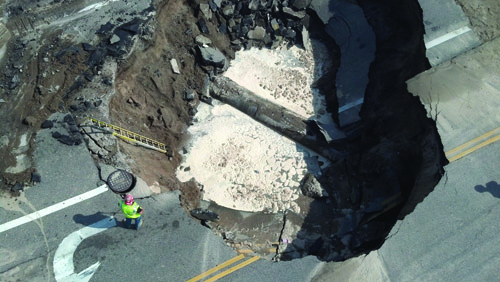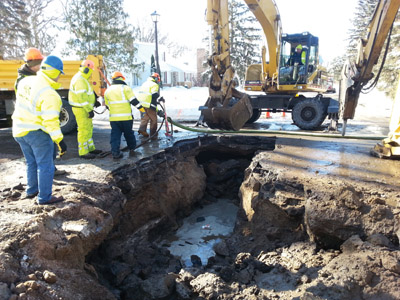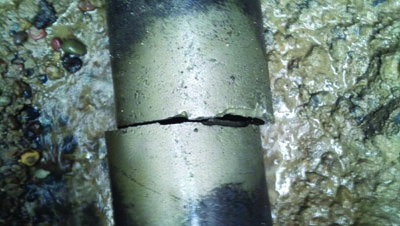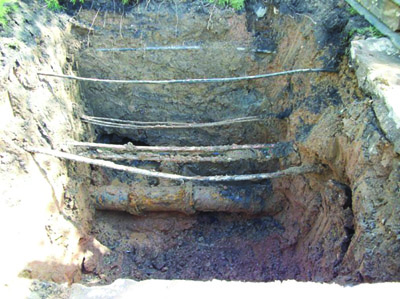Fixing A Water Main Break
The first step to fixing a water main break is finding out, exactly, where the break is located. Crews do this by putting their ear to the ground, using sonar technology to listen for the leak. Before they had this technology, Tracy says, crews had to use trial and error, digging up parts of the street in several locations to find the source of the problem.
Once the break is located, the crew will start digging. Sometimes they can’t find a way to turn off the water flow, meaning they’ll have to go into a watery hole wearing waders as a sump pump sucks out the water.
But before they even get to the pipe, they have to navigate all the other utilities on top of the pipe, such as gas and fiber-optic lines.
“We have to go through them or around them, some way,” Janes says.
Crews will often need to dig around a concrete conduit that’s holding other utilities. They then need to place one or two wooden beams the size of telephone poles under the conduit to support it. In the hole, workers are protected from cave-ins by temporary metal walls not unlike a shark cage.
When the hole is dug, parts of the earth get exposed to sunlight, which thaws the sides of the wall. Combine this with the fact the ground is already so much softer below the frozen surface, and you have a recipe for collapse.
That’s why it’s essential to follow proper safety procedures, says Tracy.
Even though you’re protected by the metal box, when a cave-in happens it’s terrifying, like a car just slammed into the side of the box, he adds.
Even with the cold and the wet and the pressure to get the job done quickly, Janes and Tracy agree there are some lighter moments. Janes recalls a time the hole was full of water when the sides caved in. The resulting geyser showered every crew member in sight. When crews get done digging the hole, navigating the other utilities, and wading through the water, they can finally fix the pipe.
To fix a water main break, crews replace the broken section of pipe with a metal band or with new piping made of metal that’s more flexible than the material used in the past. Most piping under Golden Valley is more than 50 years old, before the enhanced metal was available, and it will be several more decades before all that old piping gets replaced.
After the repair is made and the hole is refilled, crews use a special cold-weather material to patch the street. This patch is only effective in winter, meaning that come spring, crews must replace it with a more permanent patch.
Water main breaks are a fact of life in Minnesota, especially in areas like Golden Valley, where soil conditions are less than kind to the lifespan of the pipe materials. Wholesale replacement of aging water mains will cost millions, so for years the City has been handling it on a priority basis. Each year, the City evaluates its water and sewer system, identifies the deficiencies, and replaces and rehabilitates those facilities as needed as part of its Pavement Management Program.









